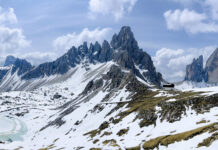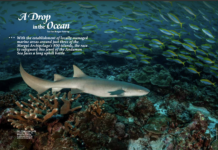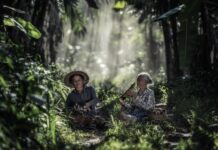
Ivan Carter’s quest for animal conservation
Text Wan Phing Lim
I’m sitting in a small rectangle of a room, face to face with a detective. He reaches for a cup of chamomile tea, then proceeds to question me. “Do you have children?” he asks.
“Me? No,” I replied.
“Well, you might have children some day,” he says. “And they’ll get to see wild elephants because you played in role in preserving them.” I reach for a jumbo fry and smile inside. These are the words of wildlife detective Ivan Carter, the face behind Carter’s W.A.R., a television programme currently on air on Outdoor Channel Asia. He is visiting the Asian region to talk about his work on animal conservation, and I’m here to talk to him about what he does in places like Kenya, Namibia and Congo.
Face to Face with a Wildlife Detective
Ivan calls himself a wildlife detective, which means he investigates the root problems of animal poaching and hunting today. From saving elephants from ivory poachers in South Africa’s Kruger National Park to investigating a tragic crocodile attack along the Zambezi River, Ivan is at the forefront of his work.
“Calling myself a wildlife detective may sound like a good marketing catchphrase,” he admits. “But it’s really the essence of what I do. So much of my time is spent talking to guides and researchers, and I want to tell the stories that no one is telling, where the humans and wildlife collide.”
Having done back-to-back interviews all day, Ivan shows no signs of tiredness. His passion is infectious as he talks about the immense pressure that rhinos, elephants, zebras and lions are facing today. “The human population is growing so fast, but on the other hand, the wildlife is shrinking,” he says. “My aim is to educate people about the issue and make them understand the solutions instead of just the problem.”
Today, Africa is the fastest growing continent and also the poorest, and the threat of poaching and hunting in the region is more real than ever. “This show is more about how we, as members of the world community, can help educate people unfamiliar with the daily hardships of the African people,” explains Ivan.
“You see, appreciating the beauty of a wild animal is a concept that can only be understood by someone with a full stomach. A hungry population of human beings will eat everything or anything to survive, so as conservationists, we can’t just protect animals, but find solutions that involve the communities around them.”

Rhodesian Background
Indeed, the human-wildlife conflict is a difficult one to balance, but that is Ivan’s hope. Having grown up in Zimbabwe, then known as Rhodesia at a tumultuous time during the Rhodesian Bush War of the mid-1960s, Ivan is no stranger to wildlife and the outdoors.
“As far back as I can remember, I’ve always been fascinated by animals,” he recalls. “It’s just something that I’ve grown up with. My mother has pictures of me watching ants and climbing to the top of trees to look at bird’s nests. I think I was fortunate being born into a family that spent a lot of time outdoors.”
Carter’s W.A.R., which is an acronym for Wild Animal Response, is a 10-episode series that aims to engage, entertain and educate viewers into becoming a part of the solution. Besides the issues of elephant ivory poaching and rhino horn poaching, Ivan and his crew go deep into the secrets of the black market trade.
“For 25 years, I was a safari guide in Africa. I took people on wildlife tours to national parks, but my first job out of school was at a wildlife orphanage. My daily work was to rehabilitate sick, injured and orphaned animals, and that was how I developed my deep passion for conservation. It’s hard to explain when something started so far back,” he laughs.
The illegal rhino trade
“I remember a visit to the animal orphanages, where over 30 baby rhinos were rescued,” Ivan recalls. “Their first interaction with humans was watching their mothers being shot and having their faces cut off. Now, that’s a tough deal. It was emotionally-draining, but despite their tragic start, we have to look at the hope they have now with all the conservation efforts going on.”
According to reports by the World Wildlife Fund (WWF), poaching is the greatest threat facing African rhinos, with gangs increasingly using sophisticated methods like helicopters and night vision equipment to track the mammals, with some even resorting to veterinary drugs to knock them out.
The number of rhinos poached in South Africa alone increased by 9,000% since 2007, from 13 to a record 1,215 in 2014, with the demand coming mostly from Asia. Powdered horn is used in traditional Chinese medicine believed to cure hangovers and other illnesses, while in recent years, the boom in demand has come from Vietnam, where rhino horn is bought as a symbol of wealth.
“Sometimes, we are just too far away from the problem,” says Ivan. “And that is why people like me have the responsibility to tell others what’s going on in the frontline. If an animal is worth more to the community dead than alive, then they’re all going to die. But if an animal is worth more alive than dead because people are prepared to pay money to look at it – or whatever way we can give that animal value – then there is hope and a future for it.”

Passion on the Frontlines
For Ivan, filming for Season Two has already begun and promises to be another highly-compelling and provocative year. Topics covered will include the use of military tracker dogs to combat poaching, filming the rehabilitative move of elephants, lions and cheetahs, as well as getting a rare look into the work of anti-poaching teams.
“The most moving thing for me is seeing how passionate these people are on the frontline and how under-recognised and under-funded they are,” says Ivan. “You won’t believe the impact it has on us working on the show, especially our camera crew.”
“They start on day one with me and it’s just a job to them. They see the stuff that goes on and think, ‘Oh, that’s pretty cool’. But by the third or fourth day, they have become so emotionally engaged that they truly want to make a difference. That’s probably one of the biggest rewards for me in my line of work.”

A Hope and a Future
Ivan shows no signs of stopping. His next stop is Bangkok and by the time this story has gone to print, Ivan would’ve visited Taipei as well on his Asia tour, a region that is no stranger to wildlife poaching. “I feel very fortunate to be a part of this programme,” he says. “People like me have the responsibility to tell others what’s going on in the frontline. We owe it to conservation to print these stories in a way that the most number of people will read it with the greatest effect possible.”
“I said to my publicity manager, let me talk to as many people as possible. The more people we can speak to, the bigger an impact we’ll make. I mean, the media is so powerful, so don’t we all have a responsibility to tell the truth in an emotionally compelling way?” he asks.
Alas, my time with the wildlife detective has come to an end. But his zeal and passion for conservation remains with me till this day. What does he want his viewers to go away with? I ask.
“I want my viewers to know that there is hope,” says Ivan. “Amidst the turmoil of human and wildlife conflict, there are enough passionate people on the conservation front. The humans are the hope just like the humans are the problem. And with support, amazing things can happen.”
For more stories and photos, check out Asian Geographic Issue 119.










